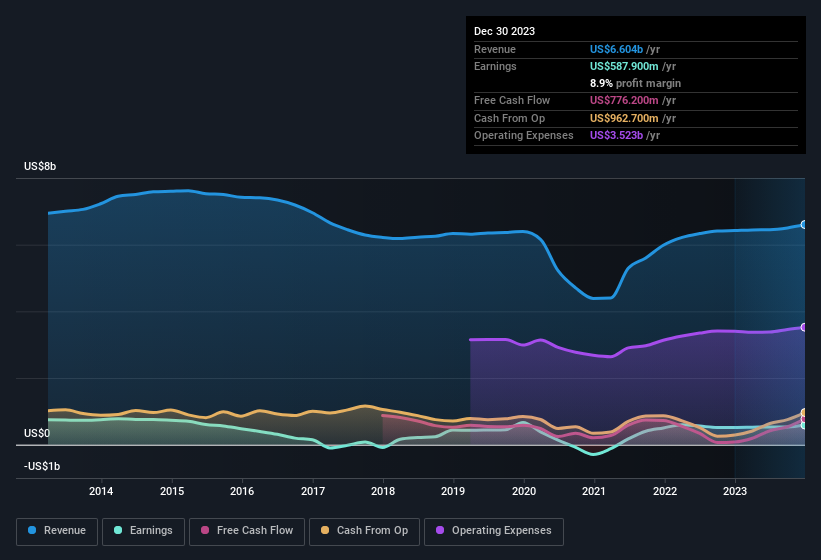- United States
- /
- Luxury
- /
- NYSE:RL
We Think Ralph Lauren's (NYSE:RL) Profit Is Only A Baseline For What They Can Achieve
When companies post strong earnings, the stock generally performs well, just like Ralph Lauren Corporation's (NYSE:RL) stock has recently. We did some digging and found some further encouraging factors that investors will like.
View our latest analysis for Ralph Lauren

Examining Cashflow Against Ralph Lauren's Earnings
Many investors haven't heard of the accrual ratio from cashflow, but it is actually a useful measure of how well a company's profit is backed up by free cash flow (FCF) during a given period. The accrual ratio subtracts the FCF from the profit for a given period, and divides the result by the average operating assets of the company over that time. You could think of the accrual ratio from cashflow as the 'non-FCF profit ratio'.
As a result, a negative accrual ratio is a positive for the company, and a positive accrual ratio is a negative. While having an accrual ratio above zero is of little concern, we do think it's worth noting when a company has a relatively high accrual ratio. To quote a 2014 paper by Lewellen and Resutek, "firms with higher accruals tend to be less profitable in the future".
Over the twelve months to December 2023, Ralph Lauren recorded an accrual ratio of -0.10. That indicates that its free cash flow was a fair bit more than its statutory profit. To wit, it produced free cash flow of US$776m during the period, dwarfing its reported profit of US$587.9m. Ralph Lauren shareholders are no doubt pleased that free cash flow improved over the last twelve months.
That might leave you wondering what analysts are forecasting in terms of future profitability. Luckily, you can click here to see an interactive graph depicting future profitability, based on their estimates.
Our Take On Ralph Lauren's Profit Performance
As we discussed above, Ralph Lauren has perfectly satisfactory free cash flow relative to profit. Based on this observation, we consider it likely that Ralph Lauren's statutory profit actually understates its earnings potential! And the EPS is up 20% over the last twelve months. Of course, we've only just scratched the surface when it comes to analysing its earnings; one could also consider margins, forecast growth, and return on investment, among other factors. If you want to do dive deeper into Ralph Lauren, you'd also look into what risks it is currently facing. Every company has risks, and we've spotted 2 warning signs for Ralph Lauren you should know about.
Today we've zoomed in on a single data point to better understand the nature of Ralph Lauren's profit. But there are plenty of other ways to inform your opinion of a company. For example, many people consider a high return on equity as an indication of favorable business economics, while others like to 'follow the money' and search out stocks that insiders are buying. While it might take a little research on your behalf, you may find this free collection of companies boasting high return on equity, or this list of stocks that insiders are buying to be useful.
New: AI Stock Screener & Alerts
Our new AI Stock Screener scans the market every day to uncover opportunities.
• Dividend Powerhouses (3%+ Yield)
• Undervalued Small Caps with Insider Buying
• High growth Tech and AI Companies
Or build your own from over 50 metrics.
Have feedback on this article? Concerned about the content? Get in touch with us directly. Alternatively, email editorial-team (at) simplywallst.com.
This article by Simply Wall St is general in nature. We provide commentary based on historical data and analyst forecasts only using an unbiased methodology and our articles are not intended to be financial advice. It does not constitute a recommendation to buy or sell any stock, and does not take account of your objectives, or your financial situation. We aim to bring you long-term focused analysis driven by fundamental data. Note that our analysis may not factor in the latest price-sensitive company announcements or qualitative material. Simply Wall St has no position in any stocks mentioned.
About NYSE:RL
Ralph Lauren
Designs, markets, and distributes lifestyle products in North America, Europe, Asia, and internationally.
Flawless balance sheet with solid track record.
Similar Companies
Market Insights
Community Narratives



